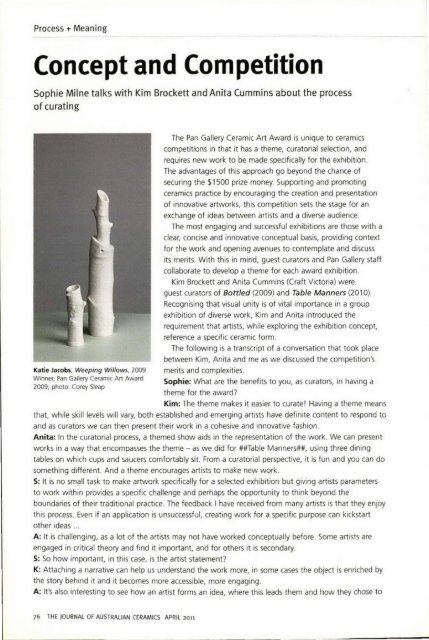The Journal of Australian Ceramics Vol 50 no 1 April 2011
Create successful ePaper yourself
Turn your PDF publications into a flip-book with our unique Google optimized e-Paper software.
Process + Meaning<br />
Concept and Competition<br />
Sophie Milne talks with Kim Brockett and An ita Cummins about the process<br />
<strong>of</strong> curating<br />
Katie Jacobs, Weeping Willows, 2009<br />
Winner, Pan Gallery Ceramic An Award<br />
2009; photo: Corey Sioap<br />
<strong>The</strong> Pan Gallery Ceramic Art Award is unique to ceramics<br />
competitions in that it has a theme, curatorial seledion, and<br />
requires new work to be made specifically for the exhibition.<br />
<strong>The</strong> advantages <strong>of</strong> this approach go beyond the chance <strong>of</strong><br />
securing the $ 1<strong>50</strong>0 prize money. Supporting and promoting<br />
ceramics pradice by encouraging the creation and presentation<br />
<strong>of</strong> in<strong>no</strong>vative artworks, this competition sets the stage for an<br />
exchange <strong>of</strong> ideas between artists and a diverse audience.<br />
<strong>The</strong> most engaging and successful exhibitions are those with a<br />
clear, concise and in<strong>no</strong>vative conceptual basis, providing context<br />
for the work and opening avenues to contemplate and discuss<br />
its merits. With this in mind, guest curators and Pan Gallery staff<br />
collaborate to develop a theme for each award exhibition.<br />
Kim Brockett and Anita Cummins (Craft Vidoria) were<br />
guest curators <strong>of</strong> Bottled (2009) and Table Manners (2010).<br />
Recognising that visual unity is <strong>of</strong> vital importance in a group<br />
exhibition <strong>of</strong> diverse work, Kim and Anita introduced the<br />
requirement that artists, while exploring the exhibition concept,<br />
reference a specific ceramic form.<br />
<strong>The</strong> following is a transcript <strong>of</strong> a conversation that took place<br />
between Kim, Anita and me as we discussed the competition's<br />
merits and complexities.<br />
Sophie: What are the benefits to you, as curators, in having a<br />
theme for the award?<br />
Kim: <strong>The</strong> theme makes it easier to curate l Having a theme means<br />
that, while skill levels will vary, both established and emerging artists have definite content to respond to<br />
and as curators we can then present their work in a cohesive and in<strong>no</strong>vative fashion .<br />
Anita: In the curatorial process, a themed show aids in the representation <strong>of</strong> the work. We can present<br />
works in a way that encompasses the theme - as we did for ##Table Manners##, using three dining<br />
tables on which cups and saucers comfortably sit. From a curatorial perspedive, it is fun and you can do<br />
something different. And a theme encourages artists to make new work.<br />
S: It is <strong>no</strong> small task to make artwork specifically for a seleded exhibition but giving artists parameters<br />
to work within provides a specific challenge and perhaps the opportunity to think beyond the<br />
boundaries <strong>of</strong> their traditional pradice. <strong>The</strong> feedback I have received from many artists is that they enjoy<br />
this process. Even if an application is unsuccessful, creating work for a specific purpose can kickstart<br />
other ideas ...<br />
A : It is challenging, as a lot <strong>of</strong> the artists may <strong>no</strong>t have worked conceptually before. Some artists are<br />
engaged in critical theory and find it important, and for others it is secondary.<br />
S: So how important, in this case, is the artist statement?<br />
K: Attaching a narrative can help us understand the work more, in some cases the objed is enriched by<br />
the story behind it and it becomes more accessible, more engaging.<br />
A: It's also interesting to see how an artist forms an idea, where this leads them and how they chose to<br />
76 THE JOURNAL OF AUSTRALIAN CERAMICS APRIL <strong>2011</strong>

















